Too often we see frost-protection thermostats set at too high a temperature, meaning that an unoccupied building will be heated for longer, and maintained at a higher temperature, than is necessary for the purpose of preventing water services from freezing.
The diagram on the right shows how a common type of mechanical frost thermostat can be prevented from having too high a switching temperature set. Or from being set dangerously low, for that matter. There is a protrusion on the dial and a series of bendable tabs is provided on a backplate which stop it at either end of the desired travel (in this case +2°C to +6°C). Your electrician will know how to do it.
Automatic control is one of the topics in our current season of energy technology briefings
